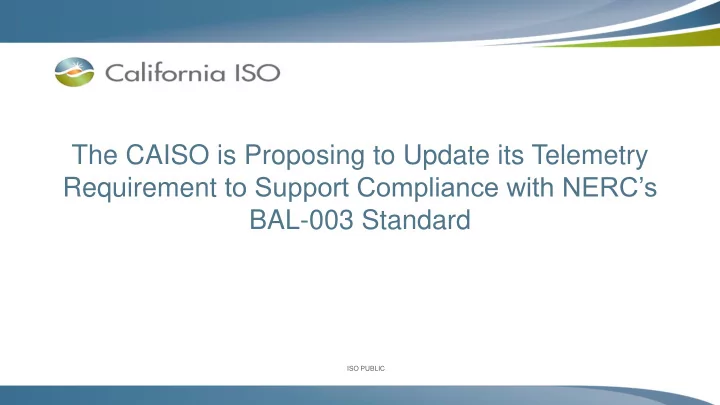

The CAISO is Proposing to Update its Telemetry Requirement to Support Compliance with NERC’s BAL-003 Standard ISO PUBLIC ISO PUBLIC
CAISO current Tariff requirements • CAISO Tariff section 4.6.5.1 provides in part: – Participating Generators with governor controls that are synchronized to the CAISO Controlled Grid must respond immediately and automatically outside a deadband in proportion to frequency deviations through the action of a governor to help restore frequency to the scheduled value. Participating Generators shall set the governor droop for each Generating Unit with governor controls no higher than 4 percent droop for combustion turbines and 5 percent droop for other technology types; with a deadband no larger than +/- 0.036 Hz. Participating Generators will not inhibit the real power response of their Generating Units with governor controls by any means that would override the governor response except as necessary to address physical operational constraints for reasons that include ambient temperature limitations outages of mechanical equipment or regulatory considerations. • CAISO current pro forma interconnection agreements require: – All large and small synchronous and non-synchronous resources to install, maintain, and operate equipment capable of providing primary frequency response as a condition of interconnection, including operating requirements of a maximum droop setting of 5 percent and deadband setting of ±0.036 Hz. ISO PUBLIC Page 2
On January 16, 2014, FERC approved reliability standard BAL-003-1 “Frequency Response and Frequency Bias Setting,” submitted by NERC • NERC BAL-003-1.1 Reliability Standard require CAISO to have sufficient Frequency Response to maintain Interconnection Frequency within predefined bounds by arresting frequency deviations and supporting frequency until the frequency is restored to its scheduled value • In order to facilitate primary frequency support in the Western Interconnection, WECC created PRC-001-WECC-CRT1.2 to require generating resources with a governor to have a droop setting within a specified range. • The CAISO is updating telemetry requirements to support compliance with NERC’s standard ISO PUBLIC Page 3
Why is telemetry requirement needed ? Due to a changing resource mix and fundamental shift in the operational characteristics of the power system with potential BA reliability implications, a NERC task force and the CAISO assessed the impacts and identified measures to monitor continued grid reliability and resiliency Goals: 1) Calculate the primary frequency response for each generation resource and interconnection minimum frequency response, monitoring actual frequency response of the interconnection 2) Setting governor dead band and droop parameters, and providing primary frequency response performance requirements 3) Maintain and monitor sustained frequency response (20s to 52s) and avoid primary frequency response withdrawal at a plant level ISO PUBLIC Page 4
Primary and Secondary Frequency Reponses ISO PUBLIC Page 5
Request for additional telemetry data requirements 1) Droop setting in percent for existing and new resources 2) Governor blocking status(ON/OFF) 3) Governor or governor like dead band(mHz) settings 4) Operational unit ramp rate(MW/min) programmed in plant DCS Note : Existing telemetry scan rate is applicable for additional telemetry points ISO PUBLIC Page 6
Governor droop or droop-like settings should be set between 3% to 5% The definition of droop is the amount of speed (or frequency) change that is necessary to cause the main prime mover control mechanism to move from fully closed to fully open. A governor tuned with speed droop will open the control valve a specified amount for a given disturbance Droop settings of 3% – 4% depending on turbine type 1) 2) Nuclear and others should set to 5% 3) The droop settings should not be less than 3% or greater than 5% Source: PRC-001-WECC-CRT-1.2 ISO PUBLIC Page 7
Governors blocking status is an additional requirement Blocking the governor of a generator essentially bypasses the governing feedback mechanisms and maintains the generator at a fixed output level. Although this action may facilitate generator control for plant personnel, serious system problems may arise if too many generators are operating with blocked governors. These problems include: a) System instability can occur since fewer units will be capable of reacting to system frequency deviations b) Restoration of system frequency to normal frequency following a disturbance may take longer c) Loading on interties can be further aggravated during system disturbances ISO PUBLIC Page 8
Governor or governor-like deadband • Dead band may be used by some manufacturers and generation operators to reduce activity of controllers for normal power system frequency variations and may be large (about .05 Hz) to affect overall power system frequency control performance. • Maximum dead band settings should not exceed ±36 mHz (59.964 Hz to 60.036 Hz) • NERC Policy 1C, Guide 3 suggests "Governors should, as a minimum, be fully responsive to frequency deviations exceeding ± 36 mHz." ISO PUBLIC Page 9
Operation ramp rate should be observed by all resources Ramp rate: The CAISO is currently evaluating its control performance, which may require imposing ramp rates (MW/min) on all resources ISO PUBLIC Page 10
Team discussion and Q & A Useful link: Direct Telemetry BPM https://bpmcm.caiso.com/Pages/BPMDetails.aspx?BPM=Direct%20Telemetry • For more follow up questions, please contact: • Sirajul Chowdhury • schowdhury@caiso.com Thank You ISO PUBLIC Page 11
Recommend
More recommend